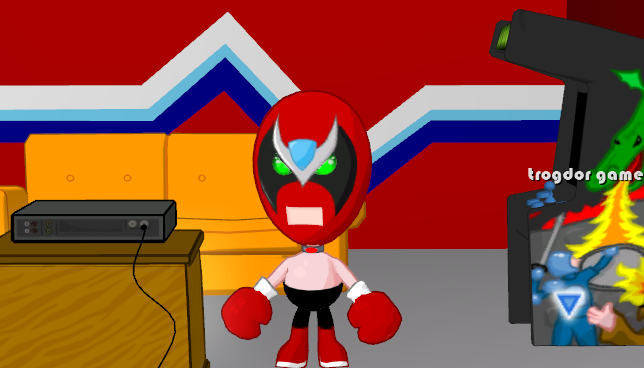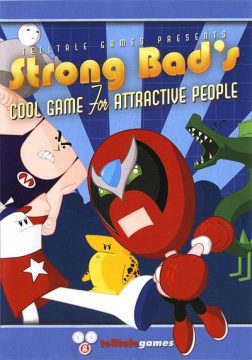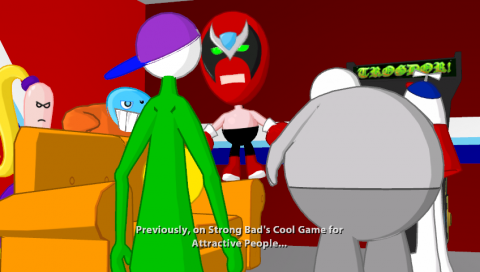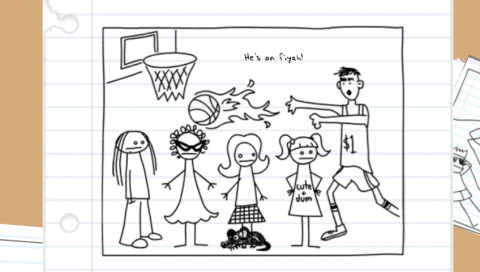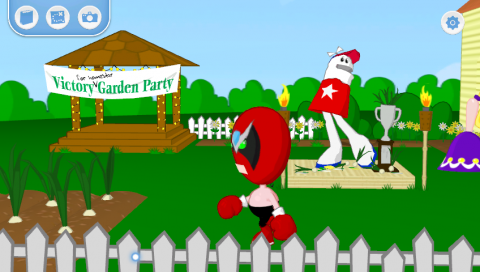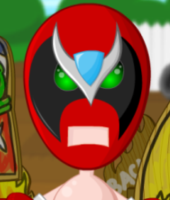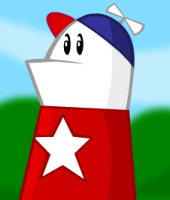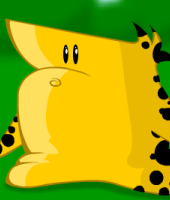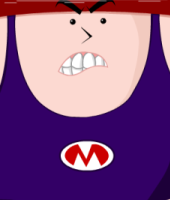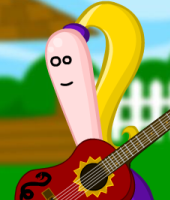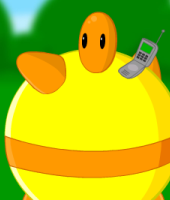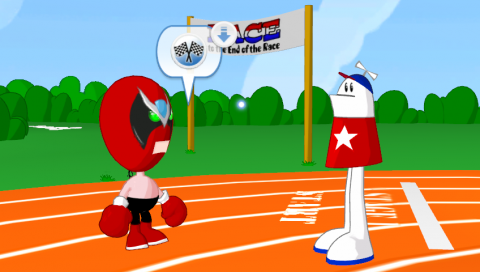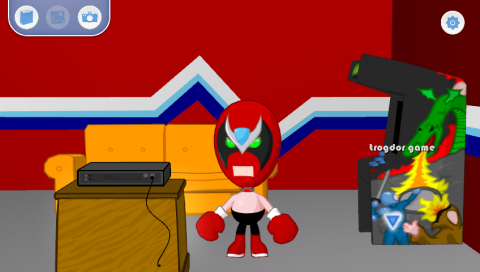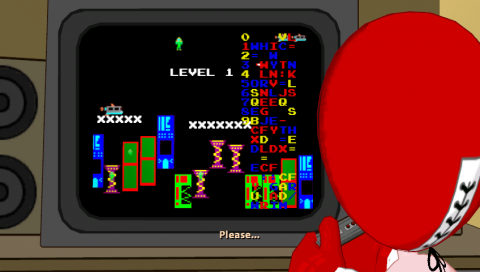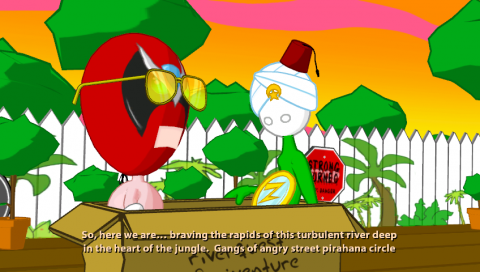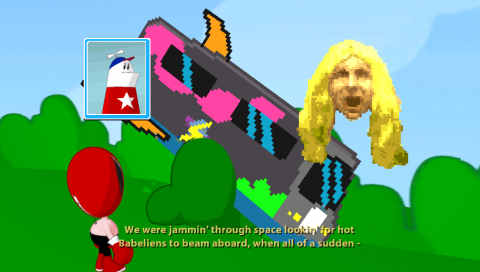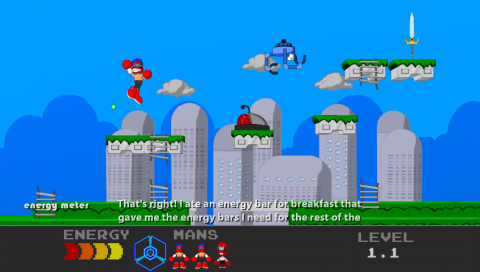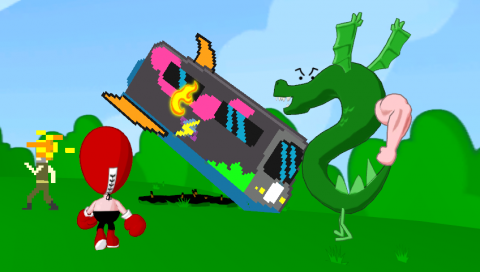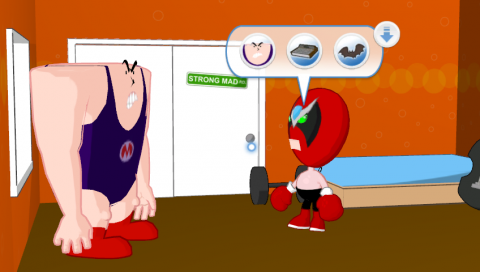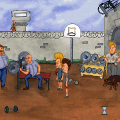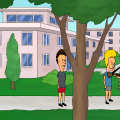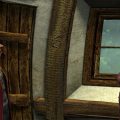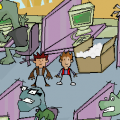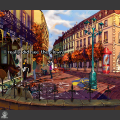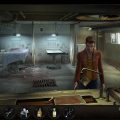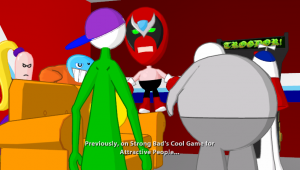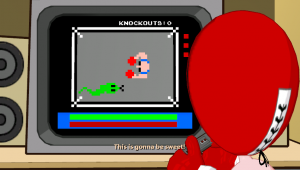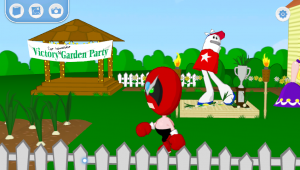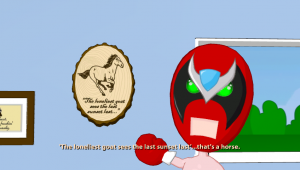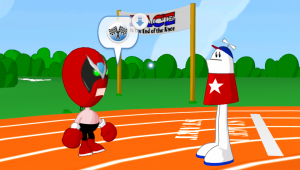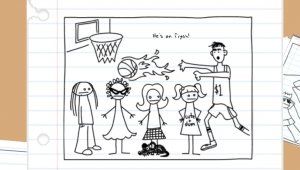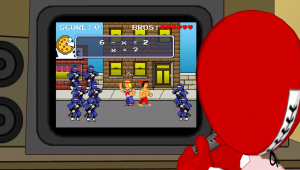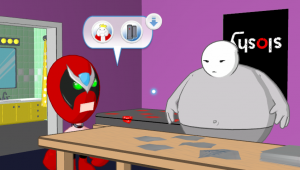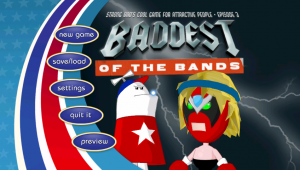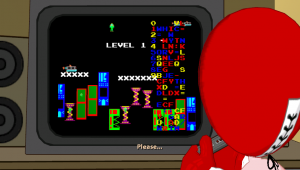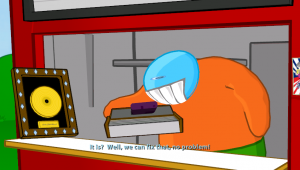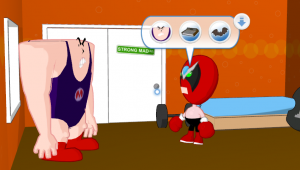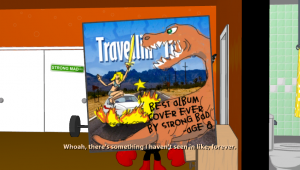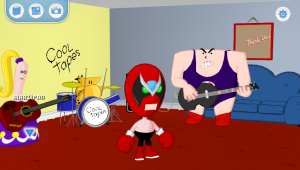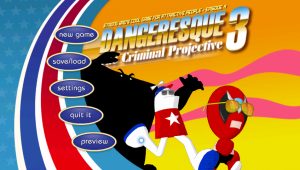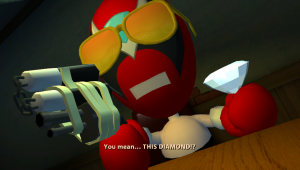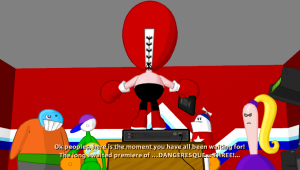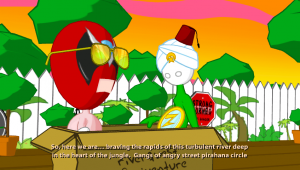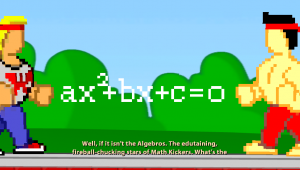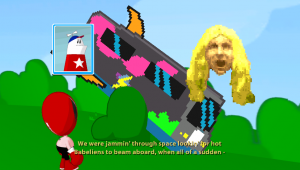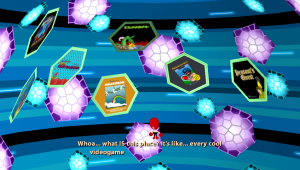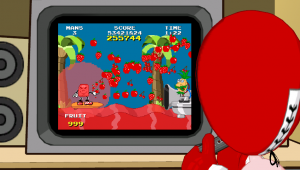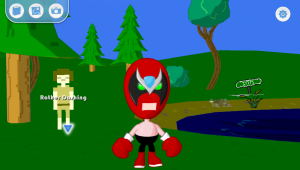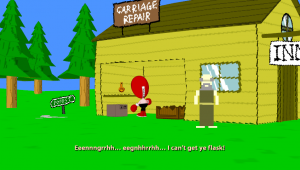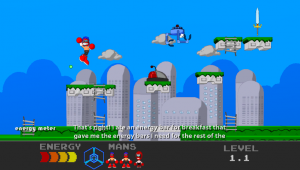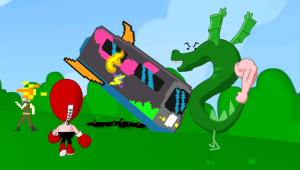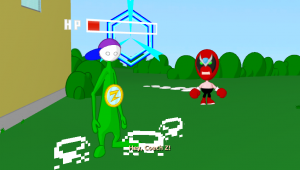MISSING A FEW CHARACTER PICS
“Everybody loves the Homestar Runner. He is a terrific athlete.” These two sentences kick off the children’s book, The Homestar Runner Enters the Strongest Man in the World Contest by Mike Chapman and R. Craig Zobel. After recruiting Matt Chapman, Mike’s younger brother and thereby forming The Brother Chap (or TBC), they decided to take their characters to the internet in the form of Flash animations. These silly little cartoons slowly evolved into a website which exhibited the goofy misadventures of Homestar and his friends.
Homestar Runner is a white humanoid figure-thing with long legs, a bright red shirt, and no apparent arms. He is ostensibly the main character, but he was quickly overshadowed in popularity by his self-proclaimed nemesis, the sarcastic smack-talking miscreant Strong Bad. Strong Bad, who wears a mask and boxing gloves and was modeled after a character in Data East’s Tag Team Pro Wrestling game for the NES. He started out as a stereotypically evil villain who wanted to fight Homestar just to prove how bad he is, but he became less of a nemesis and more of a basically harmless jerk. The interplay between Homestar Runner and Strong Bad alone could make for a nigh-endless string of cartoons, but the universe grew to include a colorful and bizarre cast of nearly a dozen other regular characters and a MASSIVE amount of bit characters who often show up more than once. However, TBC would find their main claim to H*R‘s fame through the Strong Bad Emails, a massive set of short toons based on Strong Bad checking his email – presumably sent by viewers, although it’s never quite clear – and making hilarious responses to them. The SBEmails would eventually grow beyond simple snarky responses and become crazy cartoons based on the daily life of Strong Bad.
Homestar Runner is undoubtedly a very strange series. The humor is aimed at a college/young adult demographic with its jokes about pop culture, movies, music, the Internet, and video games. While its surreal nature may incite some comparisons to Cartoon Network’s [adult swim] line of programs, Homestar Runner is much more innocuous and child-like, preferring that its absurdist humor lie strictly in PG-rated territory. It loves making up words and reveling in grammatical awkwardness, with its brightly colored cast of characters delivering insane non-sequiturs that are somehow immensely quotable. The soundtrack consists of hilariously inane looping Casiotone keyboard music, and there’s a distinct sense of retro nostalgia abound, having been created by children of the 80s.
Among other things, this case is responsible for in-universe spinoffs such as Teen Girl Squad, a sketchily drawn comic book illustrating the antics of stereotypical adolescent girls, obsessing over girls and randomly getting killed; Cheat Commandos, a heroic squadron of action figure; Limozeen, a semi-actual rock band almost akin to Spinal Tape; and the ever-awesome Internet meme, Trogdor the Burninator, an S-shaped dragon with gigantic muscular arms and a penchant for burninating.
Homestar Runner became an underground media sensation to the point where The Brothers Chaps’ merchandise store on the website earned them enough profits to make that a job in and of itself. On top of that, it grew to include several actually good flash games available for play on the website courtesy of TBC’s programmer friend, Jonathan Howe. These games would be made under the fictional video game company Videlectrix, apparently run by two guys with mustaches obsessed with good graphics (good for early-to-mid ’80s style graphics anyway). The most notable game featured on the site is Peasant’s Quest, an outright parody and homage of Sierra’s King’s Quest series. Considering The Brothers Chaps’ love for video games, it would only be a matter of time before a full-fledged retail game would be based upon the H*R universe. It was decided that a graphic adventure game would be best to explore the Homestarverse, and who better to create the game than Telltale Games. The game became Strong Bad’s Cool Game for Attractive People, or SBCG4AP for short.
SBCG4AP takes place in five episodes based around the zany misadventures of Strong Bad and the people with whom he is forced to interact with in day-to-day life. Each episode SBCG4AP is more or less isolated from each other, as each tells their own story without linking into one great big overall narrative. However, they share the same gameplay and environments with each other with each one featuring familiar locales from the H*R universe. It’s neat to be able to explore them in full, especially the overall House of Strong, the dwelling whose architecture has been ambiguous up until the game’s release. While each episode has Strong Bad visiting the same essential environments, circumstances for each episode change the terrain creatively, and for the final episode, quite literally.
The story takes place in their home nation of good ol’ normal Free Country USA for the first episode, but it eventually becomes a broken nation with several subdivided territories, a concert field featuring four competing bands, a movie set with fictional locations all over the world, and a video game map connected to other actual video games. It may get a bit monotonous to traipse through The Field for five games straight, but it’s also interesting to see the extent that each episode changes the locations without ACTUALLY taking place at too many new areas. Each episode has its own minigame, made by Videlectrix, as well as unique puzzles involving the Teen Girl Squad and other characters.
SBCG4AP uses the same single-icon point-and-click interface as Telltale’s other earlier games, and is generally uncomplicated. The map screen allows Strong Bad to instantly move to an area based on his own crudely-drawn styles, and you can even arrange the areas in order of convenience. There’s also a camera with which you can take pictures of the many areas in each game, as well as pics of Strong Bad himself dressed up in various clothing items found as collectibles in each episode in a transdimensional photo booth called the “Snap Shack.” However, the dynamic 3D environments move along with Strong Bad as the cursor stays in place, which can lead to some erroneous clicking while Strong Bad is moving and makes item interaction slippery. It’s not perfect and can be cumbersome to navigate sometimes, but it’s nothing too deal-breaking for most adventure gamers.
Characters
Strong Bad
The sarcastic smack-talking protagonist of the games. Strong Bad was originally created to be the main adversary against the eponymous Homestar Runner, but thanks to his hilarious no-guff-taking attitude fostered through the Strong Bad Emails, he became the most popular character on the website. He started out as a stereotypically evil villain who wanted to fight Homestar just to prove how bad he is, but he became less of a villain and more of a basically harmless jerk. His wrestling mask and boxing gloves apparently serve as his ACTUAL face and hands, but if an email asks him the question, “How can you type with boxing gloves on your hands?” the only natural response is for the email to be DELETED!
Homestar Runner
The “main character” of the website and a terrific athlete. In the early days of the website, Homestar started out as a good-hearted but slightly dopey protagonist who would foil Strong Bad’s evil schemes. While Strong Bad arguably stole the main character mantle for a while with the SBEmails, Homestar became a far more significant and hilarious character when he would start popping up in the emails to royally screw up Strong Bad’s responses. He is the good-hearted and fun-loving foil to Strong Bad’s acerbic edginess, but his idiocy can sometime lead to more chaos than SB creates on purpose.
The Cheat
This little yellow fellow is Strong Bad’s partner-in-crime. The Cheat (yes, his first name is The) may look adorable on the outside, but within his squat stature lies a mischievous prankster who will do almost anything for Strong Bad. They have a good working relationship for the most part, and The Cheat is successfully rewarded for his deeds with pencil shavings, which he believes is legal tender. He speaks in unintelligible squeaks, but naturally, everyone else understands him fine. He is also prone to being kicked by Strong Bad and other characters for no apparent reason other than being small.
Strong Mad
A square-shaped no-necked juggernaut and the older brother of Strong Bad. He often plays cohort to Strong Bad alongside his best friend, The Cheat. The only two things that are small about Strong Mad are his temper and his intelligence quotient. While physically powerful and prone to punching things, Strong Mad has the mindset of a child and a tenuous grasp on the English language. He is curiously the most human-like of the main characters with a nose and five-fingered hands, even if his head and body seem to be one of the same. HE ALSO HAS NO INDOOR VOICE!
Strong Sad
The oft-downtrodden younger brother of Strong Bad. Treated as even less of a Strong brother than The Cheat by his two older brothers and generally disliked by much of Free Country’s inhabitants, Strong Sad’s forte is whining (and sometimes dining on exotic worldly cuisine). He embodies the stereotype of emo college nerds with his fondness for alternative rock and independent films. Strong Bad almost never refers to him by name, often calling him some creative variety of “dump” or making reference to his weight. He also goes completely nuts when exposed to caffeine, or even Sanka.
Marzipan
Homestar’s overbearing hippie-esque kinda-sorta girlfriend. She cares about voting for whales, saving the environment from poor computer use, and a plethora of other liberal issues that she pesters other characters about, usually Homestar. The two have a rocky relationship that’s come to the point where they’re boyfriend and girlfriend simply because Marzipan says they are, a variable day-to-day choice. While she thinks that eating meat is murder, she believes that soy is also murder. She’s also a bit insane and refers to inanimate objects as living beings, like her plant Credenza and her guitar Carol.
Bubs
The local businessman of Free Country USA. He runs Bubs’ Concession Stand, which is apparently the only area for commerce in town, and he manages to accrue all sorts of weird items for sale, not all of it legal. He will overcharge for inexpensive stuff and charge anything for free stuff, and he is apparently licensed in various other trades, such as paranormal investigator, normal investigator, and a not-medical doctor of TV/VCR repair. He also has an alter-ego known as the Thnikkaman, who gives everyone “some,” and does all sorts ambiguous stuff at Decemberween.
Coach Z
Homestar’s coach and the all-around sports guy who knows very little about sports. He started out as a somewhat competent coach who had a massive Midwestern accent impediment, being unable to say the word “Job” in a straight fashion. As the series went on, he developed a creepy obsession with Marzipan and earned a reputation as the butt-pattingest coach in whatever league for whatever sport they play. He also enjoys rapping a lot more than coaching, though he’s quite a poor lyricist and often ends up saying his name and counting to two during freestyles.
Pom Pom
Homestar’s rotund best friend. He only communicates using bubble noises, which is apparently the same sound clip of Mike Chapman blowing soda bubbles with a straw. He is Homestar’s main man, his dog, his ace-in-the-hole, despite him frowning a lot at Homestar’s exhibitions of dumbness. He serves as the cool no-nonsense yin to Homestar’s idiot yang in addition to being a ladies’ man and a bonafide martial artist. However, he can be a bit of a snob to other characters, like when he blew off Strong Bad after being accepted into Cannes.
The King of Town
The apparent ruler of Free Country USA. The KoT is thought of as a loser by the citizens of the land, probably because he has never shown to care about any sort of democracy or monarchy or whatever. The only thing he’s really concerned with is eating, and… even MORE eating. The KoT became a glutton of such immense proportions that his belch bubbles generate entire fried eggs when popped. His eating extends to condiments, deodorant sticks, erasers, and a bunch of other stuff which really should not be eaten, with the apparent exception of peas.
The Poopsmith
A silent employee of the King of Town. He appears to do nothing but shovel actual crap for a living, often referred to as “whatsit,” and his gloves are permanently stained with said whatsit. He helps out the King with other odd jobs as well, such as heading up his high school marching band and serving as his bodyguard for his military task force, “The Municipality.” He also never speaks due to a vow of silence, but his official singing voice is John Linnell from They Might Be Giants.
Homsar
A flagrantly bizarre little man whom almost no one can understand. Homsar’s existence is based on a typo of “Homestar” in SBEmail #2, where a fan named Vinnie asks Strong Bad, “If you hate Homsar so much, why don’t you kill him?”He speaks in a ridiculous dopey voice and often says incomprehensible babble to the other characters, with phrases such as “Climb aboard, I brought my best foot flowered,” and “Here comes the yogurt patrol!”
In episode 1, Homestar Ruiner, Strong Bad wakes up from the basement couch and gets right to the SBEmail checkin’ for the day. He receives an email that asks him, “If you hate Homestar so much, why don’t you beat the snot out of him?” Strong Bad accepts this as a challenge and meets Homestar down at the track, where he declares his intentions and is quickly brushed off. Instead, Strong Bad decides to beat Homestar in the Free Country USA Triannual Race to the End of the Race but unfortunately his athletic skills aren’t quite up to his rival’s prowess. Instead, he works to disguise himself as Homestar and blow the race on purpose.
After Homestar loses the race and becomes a wanted felon for public nudity (don’t ask), he becomes so depressed that he crashes on the couch in Strong Bad’s basement and refuses to leave until his glory and pride are reclaimed. Oopsie. Strong Bad has to redeem Homestar’s reputation so that he’ll leave the House of Strong, but it will take some serious guts and gumption to set things right back to where they were and get the no-armed whitey outta the house.
The minigame for this episode is Snake Boxer, an overhead puncher somewhat reminiscent of Boxing for the Atari 2600. Playing as Snake Boxer Joe, you fight increasingly powerful snakes in fist-to-fang matches which increase in speed with the more snakes you KO. Snakes can be hard to sidestep, but holding right has Joe block their strikes. Inputting a secret code (found in a torn-off manual page) allows you to play as a giant cobra which strikes faster than Joe and breathes fire to boot.
The second episode, Strong Badia the Free, begins Strong Bad is answering an e-mail about the dumbest law that the King of Town has ever passed when, at an appropriately inappropriate moment, the King of Town waltzes into the room and tells SB that he is in violation of the new email tax he just passed: one snack cake for every email sent or received. For refusing to pay the toll, the King of Town orders Strong Bad to be placed under house arrest.
It’s long before he escapes, retreats to the self-made nation of Strong Badia and declares outright war on the Municipality, the King’s army which basically consists of The Poopsmith wielding a whatsit-covered baton. However, Strong Bad’s act of defiance inspires the other citizens of Free Country USA to separate from the main nation and declare their own territories as private nations. For example, Strong Sad takes the House of Strong for himself and names it “Bleak House,” Strong Mad can only think up of the name “Country” for his area, and Homsar gets the “Homsar Reservation”. The ultimate goal is to perform tasks for the leaders of each country and ally them to the Strong Badian cause to wage a battle against the Castle, which ends without any violence and a bit too easily. This leads into the last puzzle of the game, which is very unique from the rest in the episodes in that it plays out like a simplified strategy game. While there aren’t too many variations as to how it can play out, it’s a neat change of interface that acts as a suitable final challenge.
The minigame for this one is Math Kickers, a hilarious spoof of Double Dragon where the Algebros, Dex and Ryu, duke it out with various ninjas and mathematical formulas. A simple algebraic equation appears at the top of the screen and ninjas appear on both sides. You can either send Dex to the left to subtract the amount of ninjas or have Ryu add the ninjas on the right side. Dex needs to get close, but his punches are faster than Ryu’s long-range addition fireballs; they also have to avoid the plus-sign shurikens thrown by the ninjas. The ninjas can also be affected by one of three special techniques recovered from lost manual pages: Logarithmic Attack, Divide by Zero, or Polar Coordinates. Amusingly enough, the bosses are complex equations which are simply “solved” by punching them until the right answer is found, decidedly making it easier than the ninjas.
With the third episode, Baddest of the Bands, Strong Bad tries to play one of his favorite games on the Fun Machine game console: Limozeen’s Hot Babelian Odyssey, based on his favorite band. Unfortunately, the console totally malfunctions and Strong Bad needs to take it to Bubs’ Concession Stand for repair. Bubs charges a steep price of “one big sack of cash,” which Strong Bad naturally does not have for him. However, inspired by the floating digitized head of Limozeen frontman Larry Palaroncini, Strong Bad decides to call on the power of ROCK to help his predicament. He decides to hold a “Battle of the Bands” contest and subsequently win said contest to obtain that one big sack of cash, and he will get the money with the sponsorship of the band! All he has to do is send in a totally kick-awesome album cover, which he makes out of a cool car on fire, a starfish, and a hot The Cheat… erm, a hot blonde, rather. He wins the contest and gets the sponsorship, but now he has to find three bands to compete against.
After tracking down the appropriate competition, Strongbad reluctantly forms “DOI” with them, a name whose initials vary depending on choices provided by the three band members (for example, Degenerate Oliveloaf Incorporated). Unfortunately, DOI totally sucks and Strong Bad reasons that the only way he’ll win is to sabotage the other three bands he helped to recruit. Even after all the sabotage, Strong Bad still needs to find a way to make his ragtag band rock harder, but if not through the music they play… then how? After clearing the episode and fixing the Fun Machine, you can finally play Limozeen’s Hot Babelian Odyssey, a space shoot-em-up which is certainly inspired by the classic Williams title Defender. You control Limozeen’s galactic tour bus and use its tractor beam to pull in Babelians to score points. However, you lose points if Nebulons (bad aliens with style that nobody likes) whisk the Babelians up through the top of the screen. You also have to weave through rogue Flying V guitars and avoid the missiles fired from the ship of the diabolical Mitch Overlord. If things get really hairy, drop a super bomb to clear the screen of all the obstacles.
The fourth episode is the confusingly named Dangeresque 3: The Criminal Projective. Many an SBEmail ago, Strong Bad showed off the trailer for his action film, Dangeresque 2: This Time, It’s Not Dangeresque 1 with the promise of Dangeresque 3: The Criminal Projective on the horizon. Now, at long last, the thrilling hold-on-to-the-seat-of-your-edge conclusion to what is now the Dangeresque trilogy is finally done and Strong Bad invites his not-so friends to watch it with him. For this episode, you play in the fictional role of Dangeresque as you travel around “the world,” although you can easily see which areas of Free Country USA each location is supposed to be. Strong Bad himself wrote the entire script, which is filled with numerous plot holes and errors. He also directed, and the actors keep botching up their lines during the production with not-so-obvious cuts made over them. There’s even a catastrophic special effects failure involving Strong Sad which was not fixed in post.
The film starts out with Dangeresque (Strong Bad) and Dangeresque Too (Homestar) holding a retirement party for their partner Reynaldo (Coach Z), when Dangeresque’s main squeeze Cutesy Buttons (Marzipan) asks Dangeresque to cure the rainforest by inventing a secret formula with exotic items from the jungles of Strong Borneo. Unfortunately, by the time Dangeresque conceives the formula, Cutesy Buttons has been kidnapped by a mysterious figure who demands that the formula be turned over to him. To get her back, he has to face two of his old arch-rivals, Baron Darin Diamonocle (Bubs) and Perducci (King of Town), to get blueprints for… something, and to enlist the help of his estranged father, Dadgeresque (played by Senor Cardgage, a creepy old man who mumbles about random stuff and may or may not be Strong Bad’s actual father).
This episode’s game-within-a-movie-within-a-game is Space Circus Catastrophe, a 3D space flight simulator thingy involving a crazy circus… in space. You have to avoid the stale circus treats (cotton candy, circus peanuts, popcorn balls) by pressing the opposite direction from which they fly in, and you have to blast the evil space clowns with your laser. However, you must not blast apart the circus performers (ringmaster, tiger, juggler, bear), but use your capture button to snag them in a bubble. Catching performers is what allows you to advance to the next level, Interestingly enough, in addition to being a side game, SCC is also played in the context of the film, where Dangeresque has to fend off the evil space clown army of the bad guy as he attempts to rescue Renaldo from the sun.
The fifth and final episode is 8-Bit is Enough. As a result of a failed attempt to escape an angry mob of viewers who thought Dangeresque 3 sucked, Strong Bad whams his head on his Trogdor arcade game cabinet. This causes it to have the most awesome malfunction ever – the console sprouts Trogdor’s legs, wings, and beefy arm as it runs out of the room, terrorizing Strong Sad! Strong Bad deems thinks this is incredibly cool at first, but he can never play the machine again until it gets fixed. Though a series of typical bizarre events, the cabinet malfunctions ever further, causing a severe fluctuation in the universe and completely transforming Free Country USA into a video game!
Strong Bad only finds this transformation awesome for up until he sees Strong Badia, having been burninated by the now-real Trogdor! Furthermore, Homestar has been captured by Trogdor, but he is still able to communicate with Strong Bad via a pop-up window, which Strong Bad calls “HomeSpam.” The other citizens of Free Country USA have been affected by the transformation, like The Poopsmith having become construction game character Mista Fixit. Marzipan is now Lady Crate Ape (a parody of Donkey Kong) and has kidnapped Bubs on the roof of his own concession stand. The Track is turned into the sports game “Halfathlon,” where Strong Mad is possessed by the spirit of semi-legendary Soviet semi-athlete, Putchnya Shotski. The House of Strong is overrun by redcoat ghosts from the lightgun game, Spirits of ’76. The Trogdor machine itself contains the gateway into several other video games, like Space Circus Catastrophe from the previous episode which Strong Bad refuses to enter due to evil space clowns, and Stinkoman 20X6 (a Mega Man parody and one of the playable games on the site), which is an import game that requires some fixing to get around its region lockout. Naturally, Trogdor is hiding out in his own game, Peasant’s Quest.
To take on the once-dragonman-dragon, Strong Bad gets to recruit several video game characters as items to help him out in his quest, including characters from the previous four episodes’ minigames! However, he’ll have a tough time getting into Trogdor’s stronghold, as he has to brave through the gluttonous scorpion monster Munchox, the evil wizard/princess Sluushfuund, and the dastardly Copy Protection Wheel! The path through Trogdor’s castle has an awesome change of interface, where it switches into the first-person perspective in a definite homage to Wolfenstein 3D. Afterward, there’s the finale against Trogdor himself; can he be slain, or will burnination be the ultimate fate of our good Strong Bad?!
The minigame for this time around is Gel-Arshie’s Pro Fruitboarder, a licensed shovelware title based on Gel-Arshie, an even more horrific mutation of the Fluffy Puff Marshmallow Company’s already disturbing mascot, Marshie. The goal is to rack up points by jumping up from the crimson fruit wave to snag various red fruit in midair. Grabbing fruit creates a red bubble around Gel-Arshie which slows his decent and allows him to keep jumping in midair. To boost the score higher, there are a myriad of tricks that you can perform in midair (with the two most valuable tricks hidden away in a secret manual page). However, the nefarious Professor Pineapple keeps shooting pineapple slices at you, and those are NOT red fruit. Getting hit by a slice destroys your gravity bubble, and getting hit without the shield active takes away one of your lives. What’s especially interesting about this one is that it factors into the quest even more heavily than Space Carnival Catastrophe did for Dangeresque 3, as Strong Bad has to go INTO the game itself from the Videlectrix Mainframe at some point.
And thus ends the five episode saga of Strong Bad, at least in computer gaming form. On the whole, most puzzles are not too difficult to figure out, but in fitting with the tone of H*R, some of them tend to be abstract and bizarre. Still, the stranger puzzles often fit in with the quirky feel of the series, and there’s nothing here that’s as unfair or nigh-impossible to deduce as older Sierra games. Furthermore, there is a hint gauge which you can active that will cause Strong Bad to talk to himself during the game with a pondering clue about what he should probably be doing next, which you can set in three levels from order of least to most obvious statements. There are also several bonus items which can be acquired in each episode and certain tasks Strong Bad can carry out that go towards an achievement percentage. Unfortunately, a few of these items are not only easy to miss, but they can also be lost forever in a playthrough, necessitating a total game restart to achieve 100%. It is nothing that consulting an FAQ cannot fix, but it’s still pretty frustrating if you’re the type who can’t abide a permanent 99% rating.
The graphics are quite simple and do not require any high-power processor to play. They generally do a decent job of translating the 2D drawings into 3D polygons, and from a distance, it looks almost exactly like the cartoons. However, there are some instances where it just plain looks weird. Homestar particularly looks odd with his 3D mouth movements and his underbite not quite being accurately modeled, but this is not a game that relies on its technical details. The sound design is lifted straight from the website, with strangely charming Casiotone keyboard melodies accompanying Strong Bad on his travels. The voice work is spot-on from the website with almost all character voices done by Matt Chapman, except with Missy Palmer as Marzipan and Mike Chapman doing a few voices to boot.
All five episodes sort of assume some kind of familiarity with the material. There are tons of in-jokes and references that will just sound silly and random if you’re not familiar with them. Then again, Homestar Runner is a silly and random series anyway, even if you’ve watched the Strong Bad e-mails over and over and have bought the DVDs. It can take awhile for acolytes to become accustomed to the humor, but the longtime fanatics who have checked the Strong Bad Emails since the Tandy 400 days will undoubtedly love it.
The differences between the PC release and the Wii release are few. The PC’s framerate is a slight tad better and the clicking controls are more precise compared to the Wii version, but the Wii version is a good alternative regardless, as the differences are negligible. SBCG4AP runs on a reasonably low-powered technology for a recent PC title, and the Wii is able to handle the hardware well, much better than the considerably muddled Tales of Monkey Island port on the system which came about a year later. Years later, all episodes were ported to Mac OS X, and were released on PSN in 2010.
